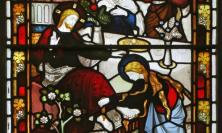The readings that we will hear on the six Sundays of Lent this year lead us towards our celebration of the victory of the resurrection. Peter Edmonds SJ plots the different routes that we might take on our journey to Easter during this Year of the Word. How does The God Who Speaks invite us to encounter him through scripture this Lent?
There are many ways of approaching the three scripture readings selected for each of the Sundays of Lent in this Year A of the Sunday cycle, all designed to help our growth in the love and understanding of Christ and our Christian commitment. The way suggested in the first part of this article invites a choice between three pathways, each of which constitutes a pilgrim path to the celebration of Easter, the high point of our Christian year. The second part of the article looks in more detail at the passages from the writings of Paul, which we welcome as companions on our pilgrimage towards Easter.
Part one: the three ways
A first way: through places
The first path consists of a journey from place to place, as explained in a previous article in Thinking Faith. This is the itinerary offered to us by the six readings for Year A of Lent from the Gospels of Matthew and John. We encounter Christ in various places in various ways. We move from the desert of temptation (Matthew 4:1-11) to the mount of Transfiguration (Matthew 17:1-9); from a well where we meet an unnamed woman (John 4:5-42) to a pool where we meet an unnamed man who has been blind from his birth (John 9:1-41); from the tomb of Lazarus in the village of Bethany (John 11:1-45) to ‘a place called Golgotha’ outside the city of Jerusalem where Jesus was crucified (Matthew 26:14-27:66).
In the previous article, we claimed that ‘through personal reading, prayer and meditation, these places can be a means to help us renew our baptismal promises at Easter time with understanding, enthusiasm and conviction’. They fit in well with the instruction repeated in the Spiritual Exercises of St Ignatius to ‘see the place’ as a key element in our prayer. All these places were sanctified by the presence of Christ and we are encouraged to meet him there.
A second way: with people
A second path concentrates on people rather than places. Various people, found in our first readings on these Lenten Sundays, help us encounter Christ in various ways. These people are certain big names in the biblical story, three of whom – Adam, Abraham and David – Luke counts among the ancestors of Jesus (Luke 3:23-38). On the first Sunday of Lent, we hear about the fall of Adam and our first parents (Genesis 2:7-9; 3:1-7). On the second Sunday, we hear about God’s call and promise to Abraham (Genesis 12:1-4). On the third we hear about Moses and the water he drew from the rock (Exodus 17:3-7), and on the fourth we hear about Samuel’s anointing of David as king (1 Samuel 16:1, 6-7, 10-13). On the fifth Sunday, we listen to the prophet Ezekiel’s vision of the dry bones that return to life (Ezekiel 37:12-14) and on Passion Sunday, the sixth, we are introduced to the intriguing figure of the Servant who dominates four poems – the Servant Songs – of the prophet known as Second Isaiah (Isaiah 42:1-4; 49:1-6; 50:4-11; 52:13-53:12). On this Passion Sunday, we listen to part of the third of these poems (50:4-7) and we will hear the final one in full on Good Friday.
These personalities and their stories all have parts to play in the story of Jesus told in the gospels. The first line of the New Testament identifies Jesus as ‘Son of David’ and ‘Son of Abraham’ (Matthew 1:1). Just as the Egyptian Pharaoh tried to kill the infant Moses (Exodus 2:15), so King Herod tried to kill the child Jesus (Matthew 2:16). Ezekiel’s vision of the dry bones coming to life prepares us for the claim of Jesus in his discourse at the Last Supper, reported in John’s Gospel, to be ‘the way, and the truth, and the life’ (John 14:6). Matthew applies verses of an Isaian Servant Song directly to Jesus (Isaiah 42:1-4; Matthew 12:18-21). We could choose any one of these Old Testament portraits to accompany us on our Lenten pilgrimage. Reflection and prayer on these Old Testament personalities can aid us, just as they surely aided Jesus, ‘as he increased in wisdom and in years’ (Luke 2:52). We remember Ignatius’s instruction in his Spiritual Exercises to ‘see the persons’. They will lead us to Christ.
A third way: with St Paul
If we follow the first suggested path, considering the places, we situate ourselves in the lifetime of Christ. If we follow the second, considering heroes of the past, we situate ourselves in the centuries that preceded Christ. On this third path that we propose, we join Christians of the first generations that followed the death and resurrection of the Lord. With them, we listen to the letters of Paul, which date from this time. With these ancestors of ours in the faith, we ponder the significance and achievement of Christ. We make our own the words of encouragement and exhortation that Paul addressed to them. His words find their place in our liturgy as second readings, readings that are often neglected.
We may look for links between these second readings and the ones that precede and follow them – those about the people and places of the Old Testament, and the gospel readings, respectively. Alternatively, we may be happy to appreciate Paul’s letters in their own right. We must not forget the advice Ignatius gives in the Spiritual Exercises (§2) that it is ‘not much knowledge but the inner feeling and relishes of things that fills and satisfies the soul’.
On the first, third and fifth Sundays, we listen to passages from Paul’s Letter to the Romans. On the second, we hear verses from his Second Letter to Timothy, on the fourth an extract from his Letter to the Ephesians, and on Passion Sunday, the best-known section of his Letter to the Philippians, the so-called kenosis hymn about the ‘emptying’ of Christ in his incarnation and humiliation on the cross.
Assembling for our liturgy on Passion Sunday, we have now arrived at the destination of our Lenten pilgrimage. We are with Jesus and his disciples in Jerusalem on the Sunday that we often speak of as ‘Palm Sunday’ because of the distribution of palms that takes place in our liturgy of the day. Some of us will have made our way reflecting on the different places where we met Jesus on the five Sundays we have spent on the journey. Others have arrived enthusiastic and knowledgeable about great figures of the Old Testament who, in God’s providence, prepared for the coming of Christ. Others will have joined believers of early Christian generations in listening to words of encouragement and explanation in the Letters of Paul. Whatever the pilgrim route we have followed, may it contribute to a fitting celebration of Holy Week and Easter that lies ahead. But let us return to those letters of Paul that we heard as second readings this Lent.
Part two: the ‘Pauline’ readings of Year A
The Letter to the Romans
The Letter to the Romans is the most profound of the Pauline letters. We can pause to reflect on the place to which it was sent. Rome was an enormous city by any standards but a city that lacked the amenities that we take for granted. There was no fire service to combat frequent fires. Mosquitoes bred without hindrance. A third of the population were slaves. It had a small Christian community of mainly Jewish origin whom Paul had never met and who may have regarded him with suspicion because of what they had heard of his teaching on the observance of certain requirements of the Jewish law, which we find explained in controversial terms in the Letter to the Galatians. This Letter to the Romans could have been penned as a treatise to give reassurance to the Roman Christians that Paul’s understanding of Christ and Christianity was one that they both shared and celebrated. We listen to this letter three times during Lent in Year A.
In our reading for the first Sunday (Romans 5:12-19), Paul presumes that his readers are familiar with the story of Adam and his sin. Paul reflects on this sin of disobedience of our first parents and its consequences for the rest of us. It was as if the tyrant sin had seized power and introduced death, and subsequently enlisted the Mosaic law, too, because although such law could identify sin, it could not provide a remedy for it.
But sin is just one side of the picture. Paul directs us to look at the other side. ‘Much more’ important is God’s response of the grace and gift brought through ‘the one man Jesus Christ’. This first Sunday of Lent is a good time for us to make a theological reflection on our own understanding of sin and grace. There are obvious echoes in this passage of our first reading from Genesis and the gospel reading in which Jesus encounters Satan in the desert.
On the third Sunday of Lent, we hear again from the fifth chapter of Romans (5:1-2, 5-8), this time from its beginning. The word ‘faith’ in the opening verse forms a conclusion to the arguments put forward in the four chapters that precede it, in which Paul explains how God, through Christ, put right a world gone wrong. The word ‘hope’ in the next verse prepares us for the next stage of Paul’s presentation of his gospel, which will climax in his eighth chapter. The last verse of our passage includes the third of what we call the theological virtues, namely ‘love’, a love that has been poured out into our hearts.
New for the reader of this letter is the repetition three times of the name of ‘the Lord Jesus Christ’. This Sunday, then, is a good time to ponder our Christian understanding of the virtues of faith, hope and love. Less obvious perhaps is a link with the other readings. Moses might be considered as a figure of hope as he led the people of God out of oppression in Egypt and through the desert on their journey to the land God promised them. In the gospel story, we might ponder the stages by which the Samaritan woman comes to faith in Jesus and becomes his ambassador to the people of her town.
On the fifth Sunday of Lent we listen to four of the 39 verses of the eighth chapter of Paul’s Letter to the Romans (8:8-11), the chapter which for many is the most loved passage in all of Paul’s correspondence. Once again, we notice how the name of Christ is mentioned three times, but this is surpassed by no fewer than six occurrences of the word ‘Spirit’. Paul talks of the ‘Spirit of God’, the ‘Spirit of Christ’, of the Spirit of life, of the Spirit dwelling ‘in you’, these struggling inhabitants of Rome. These few verses of Paul form a good supplement to Ezekiel’s vision of the dry bones that came to life again, and to John’s account of the raising of Lazarus from death to life.
Second Letter to Timothy
The Pauline passage we hear on the second Sunday of Lent is from Paul’s Second Letter to Timothy (1:8b-10), one of the so-called ‘Pastoral Epistles’ (1 and 2 Timothy and Titus). In the First Letter to Timothy, Timothy is addressed as Paul’s ‘loyal child in the faith’; he is in Ephesus (1 Timothy 1:2-3). According to the Acts of the Apostles, Ephesus was ‘the temple keeper of the great Artemis and of the statue that fell from heaven’. It was there that a dispute between Paul and the silversmith Demetrius caused a riot (Acts 19:23-41). But there is no reference to all this in our short extract. This has been selected presumably because of its reference to the ‘appearing of our saviour Christ Jesus’ (which provides a link to the gospel reading: the Transfiguration).
We can pause over this phrase for its own sake. The Greek word that it translates is found in only six places in the New Testament, and five of these occur in these Pastoral Epistles. It refers to the second coming of Christ (his parousia). One of these texts is proclaimed at Midnight Mass at Christmas, where its reference to the ‘appearing of our great God and saviour Christ Jesus’ (Titus 2:13) is clearly applied to the birth of Christ in his incarnation. It can also be applied to the transfigured Christ of today’s gospel, whom the voice of God from heaven proclaims as ‘my Son, the Beloved’ (Matthew 17:5).
The Letter to the Ephesians
The Letter to the Ephesians that we hear on the fourth Sunday of Lent can be considered as a celebration of the Pauline vision of Christ, developing and enlarging doctrines and insights that Paul expressed in his earlier letters. A key word in our short extract (5:8-14) is ‘light’, which occurs five times. Paul urges his audience to live as ‘children of light’ in contrast to their previous way of life, which he bluntly describes as ‘darkness’. This passage makes a good pair with the story of the man born blind, which we hear as the gospel of this day. In an age that lacked the convenience of abundant light that we enjoy thanks to modern technology, light and darkness provided rich symbolism.
In John’s Gospel, Jesus proclaimed himself to be the ‘light of the world’ (8:12). In Matthew’s Gospel, in the Sermon on the Mount, the disciples of Jesus were called ‘the light of the world’ (5:14). In the earliest of Paul’s letters, Paul reminds his converts how they were all ‘children of light and children of the day’ (1 Thessalonians 5:5). As background to the Letter to the Ephesians, we can recall again the lively details of dispute and riot described in the nineteenth chapter of the Acts of the Apostles, and if we have been fortunate enough to visit the site of this ancient city in our own day, we will not have forgotten the abundant ruins of temples and idols that impress modern visitors.
The Letter to the Philippians
The second reading on Passion Sunday is the same in each year of the three-year cycle (Philippians 2:6-11). The Letter to the Philippians, despite being written by Paul when he was in prison with execution an imminent possibility, is arguably the most cheerful of his letters. Paul writes letters as a means of solving problems and one problem here was the conceit and selfish attitude of certain members of the community. Paul looked to deal with pastoral problems theologically and he approaches this one by reflecting on the foundations of the gospel he preached. We find this reflection in our second reading for Passion Sunday.
Elsewhere Paul summed up the core of his gospel message in somewhat bald factual terms: that ‘Christ died for our sins in accordance with the scriptures, and that he was buried, and that he was raised on the third day in accordance with the scriptures, and that he appeared to Cephas, then to the twelve’ (1 Corinthians 15:3-5). In Philippians, he expands this basic message in verses carefully structured in form and rich in content, so eloquently that many believe he was quoting a Christian hymn perhaps already known to his audience. In it, we can find references to Jesus’s incarnation, his having the status of a slave (rather than a servant), his emptying himself in his death on a cross, and his final exaltation. With such a vision of God become man, the worship paid God ‘by every knee and by every tongue’ that the prophet Isaiah had written about centuries before (45:23), is now offered to Christ.
Anybody who takes this hymn seriously cannot fall into the faults that Paul knew were plaguing the Philippian community. This hymn provides us with an excellent guide to understanding the Passion story that is proclaimed every year on this Sunday and represents a worthy supplement to the Servant song that we hear from Isaiah on this day. Its concluding part summarises the Easter message of Christ in terms of his exaltation and reminds us to remember that we must always balance the disaster of the cross with the victory of the resurrection.
Peter Edmonds SJ is a member of the Corpus Christi Jesuit Community, Boscombe.
Peter Edmonds SJ has also written this year’s Lent retreat from Pray as you go and Sacred Space: ‘Journeying with Jesus’. Follow the retreat at pray-as-you-go.org/article/journeying-with-jesus-a-gospel-lenten-pilgrimage






